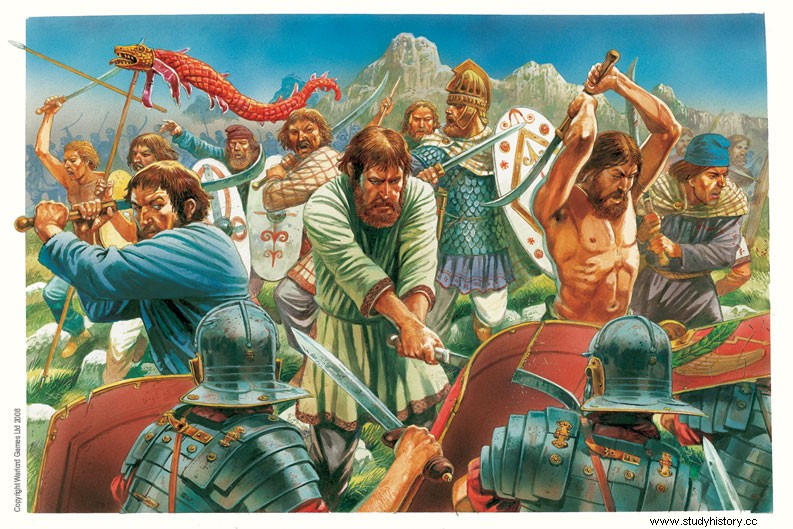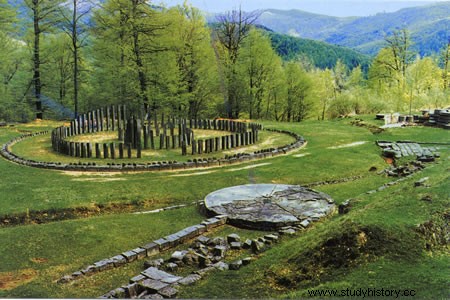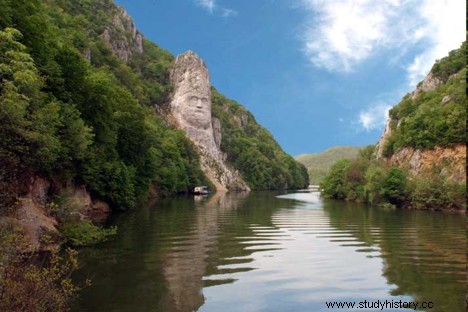Nineteenth installment of “Archienemies of Rome “. Collaboration of Gabriel Castelló.
Our archenemy of today is one of the least known barbarians, but not for that reason worth remembering his deeds, which were many and against a Roman Empire in its moment of maximum splendor.
Diurpaneo he was a Dacian leader, a territory that included present-day Romania, from the Black Sea to the middle course of the Danube. To give a brief glimpse of the character of those people, ethnically related to the Getae, Sarmatians, Roxolani and Bastarnae, here is a quote from Herodotus:
[…] the Getae believe themselves to be immortal… at the time of death they go to meet Zalmoxis (some call him Gebeleicis, who was their main god). Every four years they send a messenger chosen by lot, to meet with Zalmoxis... those in charge of sending him hold three spears, while others take him by the hands and feet, and after swinging him in the air, they throw him on the spears. If, as is logical, he dies when being pierced, they consider that the divinity is favorable to them. But if he doesn't die they insult him and call him an evil... Every time he thunders or flashes they shoot arrows into the air, angry with the sky, while threatening the god […]
Diuparneum he succeeded Burevista (not to be confused with another leader of the same name who lived in Dacia in the times of Caesar and Pompey) at the head of a kingdom divided and limited by the Scythian and Sarmatian tribes and the Roman Empire. His promotion as rex of the Dacians came from the success of their military campaigns against the Romans after preparing their troops for years, harassing the border and creating alliances with other neighboring tribes to enroll them in their Great Dacia project.

Dacians vs. Romans
In the year 87 of our era, Diuparnneo defeated a huge army commanded by a certain Cornelio Fusco , former mediocre praetorian chief sent by a weak and paranoid emperor, Domitian . In the valley of Tapae (known today as the Iron Gates in Transylvania, border between Romania and Serbia), four legions were ambushed and two of them practically annihilated, including the prestigious V Alaudae . It was probably after that great triumph that Diuparnneo took Dekebal as his title. , common to the great Dacian chieftains, whose meaning would be something like "Strong as ten men" and which etymologically comes from the Proto-Indo-European dekm – (ten) and –bal (strong). Roman historians, by translating the indigenous name into Latin, converted Dekebal in Decebalus .
A year later, Tetio Juliano , the new legate of the Danube after the ignominious death of Fusco and his men, had to lift the siege of Tapae after a revolt on the Rhine against Domitian that caused the latter to close a peace treaty between Dacia and Rome even more ignominious than the defeat of the previous year, where thousands of men, and the sacred eagles of the legions, fell into the hands of the troops commanded by Decebalus. That was the zenith of the power and influence of the Dacian leader, receiving tributes, harassing the Roman province of Moesia at will, with more and more deserters, tribes and barbarian nations around him trusting that whoever was capable of defeating Rome had arrived. as Arminio had done in Germany years ago.
One of the conditions that Domitiano accepted, more aware of his vices and phobias than of the management of the limes, was the sending of architects and engineers to Dacia for the embellishment of Sarmizegetusa , the great capital of the kingdom located on a plain of the Orastia next to a cliff with a 1,200-meter drop. The city was clustered in terraces under the great quadrangular fortress where the king resided, with a large sanctuary inside and running water through terracotta pipes. The Dacians were not shaggy barbarians, but a solid and refined nation ready to defy Rome.

Sarmizegetusa
That situation of prosperity and insolence before the Domus Flavia was maintained until an extraordinary man took over the reins of the Empire. Gone are the eccentricities and cowardice of Domitian. Shortly after being proclaimed Emperor by the Senate, following the designs of his predecessor Nerva, Marco Ulpio Trajano , born in Itálica (Santiponce, Seville), took up the Dacian affair in March 101, gathering in the Danube the most imposing army since the time of Augustus, building a bridge never seen to date over the river and defeating Decébalus that same year in the tragic place where he had humiliated Fusco years before, the valley of Tapae . While Trajan continued his overwhelming advance against the capital, Decebalus chose to cross the Danube in the opposite direction and take the theater of operations out of Dacia, an intention that was frustrated after the defeat of Adamclisi , where almost 15,000 Dacians were massacred, a resounding Roman victory that left Trajan a clear path to return to Sarmizegetusa and besiege it. Decebalus, before seeing his own starve to death, accepted the magnanimous terms of surrender that the Spaniard proposed.
The Roman victory did not dampen his ambitions. Three years after that, Decebalus he got rid of his role as tributary “client king” that Trajan imposed on him after the armistice and massacred the Roman garrison of Sarmizegetusa, unleashing the great campaign of Dacia that we can still see in Trajan's Column. Decebalus was not an ignorant and brawling tribal leader, like other barbarians whose names history swallowed. Dion Cassius he described it like this:
[…] He was a lynx for matters related to war tactics and also had a good eye for being victorious in wars. He knew how to judge shrewdly when it was good for him to attack and when it was preferable to fall back. He was an expert in the art of laying ambushes and a master of open field battles. In addition, he not only knew how to take advantage of a victory, but also how to properly manage a defeat […]
The imperial response was blunt. Three armies entered Dacia from three different points, destroying in their path all that offered resistance. After the fierce siege and assault of Sarmizegetusa, Decebalus managed to flee but was forced to commit suicide before falling into the hands of Trajan's troops. A glass found in the ruins of the old city contains a phrase that evokes how the days of such a brave king ended. A tombstone found in Greece reads that a certain Claudius Maximus was the one who sent his head and right hand to the emperor, receiving a generous gratification for it.
The conquest of Dacia in figures
The death of the leader practically meant the end of hostilities and the general surrender of Dacia. By pure chance, or by the betrayal of a certain Bicilis, the king's confidant, Trajan managed to seize the hidden treasure of Decebalus, 165,000 kg of gold and 331,000 of silver . The Dacian campaign was costly but very lucrative for Rome. Nearly 500,000 men and women they were sold as slaves, reporting for the state among all the income derived from the conquest about 2,700 million sesterces , in addition to the mining exploitation of the territory. Trajan obtained income to pay for monuments with which to beautify Rome and ordered 123 days of celebrations in which 10,000 gladiators they poured their blood on the sand…
An immense 40-meter-high rock-carved statue of the face of Decebalus can be seen near Orsova , Romania, next to the Danube, a short distance from the TABVLA TRAIANA, memory of the conquest of Dacia by Trajan in 105.

